Comprehensive Analysis of Primary Health Care Strategy and Cancer Plan
VerifiedAdded on 2022/08/12
|17
|5084
|272
Report
AI Summary
This report provides a comprehensive analysis of New Zealand's Primary Health Care Strategy (2001) and the New Zealand Cancer Plan (2015-2018), evaluating their contributions to public health. The report discusses the vision and key directions of the primary health care strategy, linking each direction with specific examples and initiatives. It also examines the impact of the New Zealand Cancer Plan, including its strengths, weaknesses, and areas for improvement from a public health center perspective, with a focus on strategies to address disparities and promote early detection and treatment. Furthermore, the report identifies smoking as a modifiable risk factor for lung cancer and explores government health promotion initiatives like Smokefree Aotearoa/New Zealand 2025 and Better Help for Smokers to Quit (BHSQ), highlighting the crucial role of nurses in implementing these strategies within the primary health care context. The report emphasizes the importance of community-based systems and self-management practices in improving patient outcomes and overall well-being.
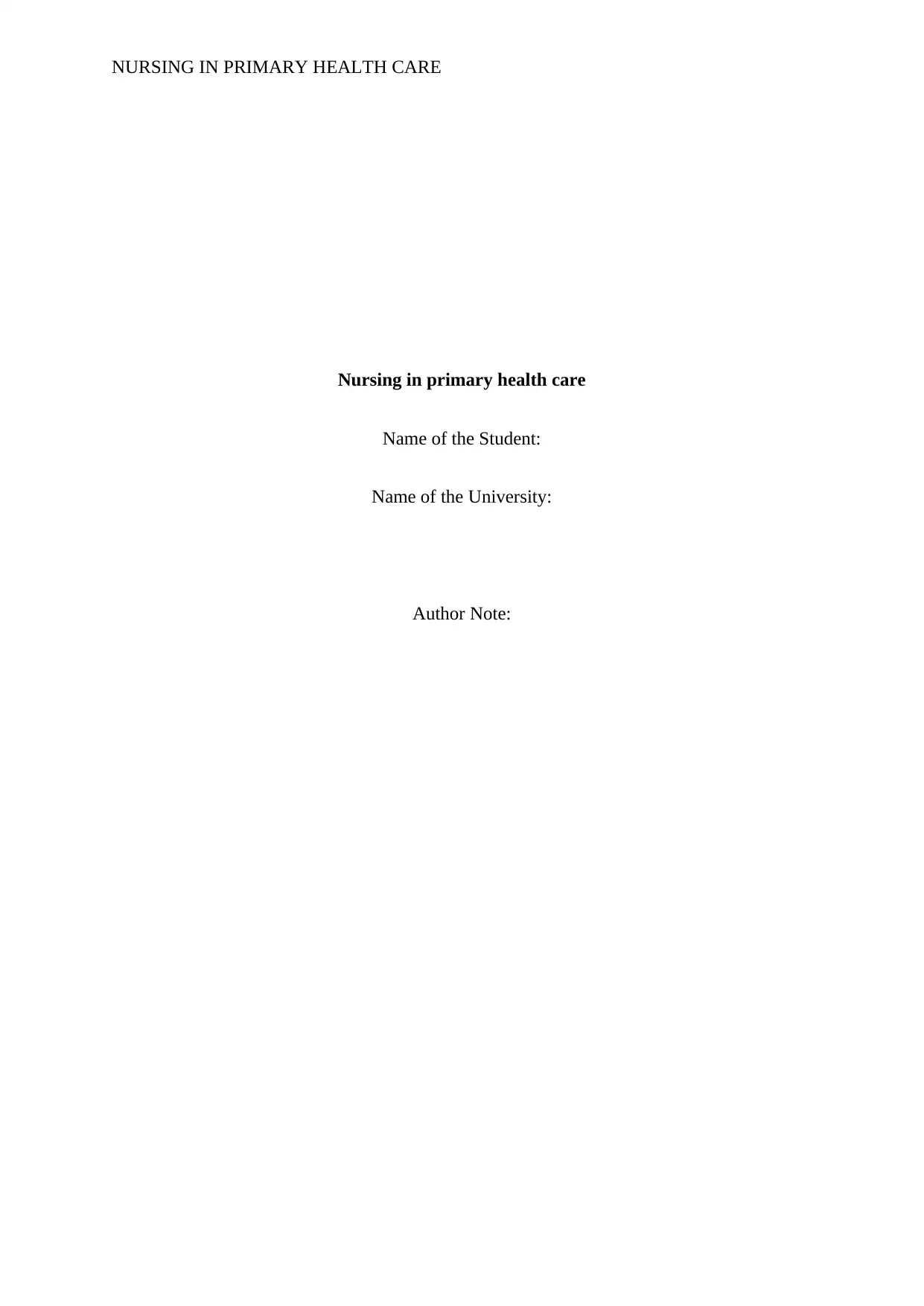
NURSING IN PRIMARY HEALTH CARE
Nursing in primary health care
Name of the Student:
Name of the University:
Author Note:
Nursing in primary health care
Name of the Student:
Name of the University:
Author Note:
Paraphrase This Document
Need a fresh take? Get an instant paraphrase of this document with our AI Paraphraser
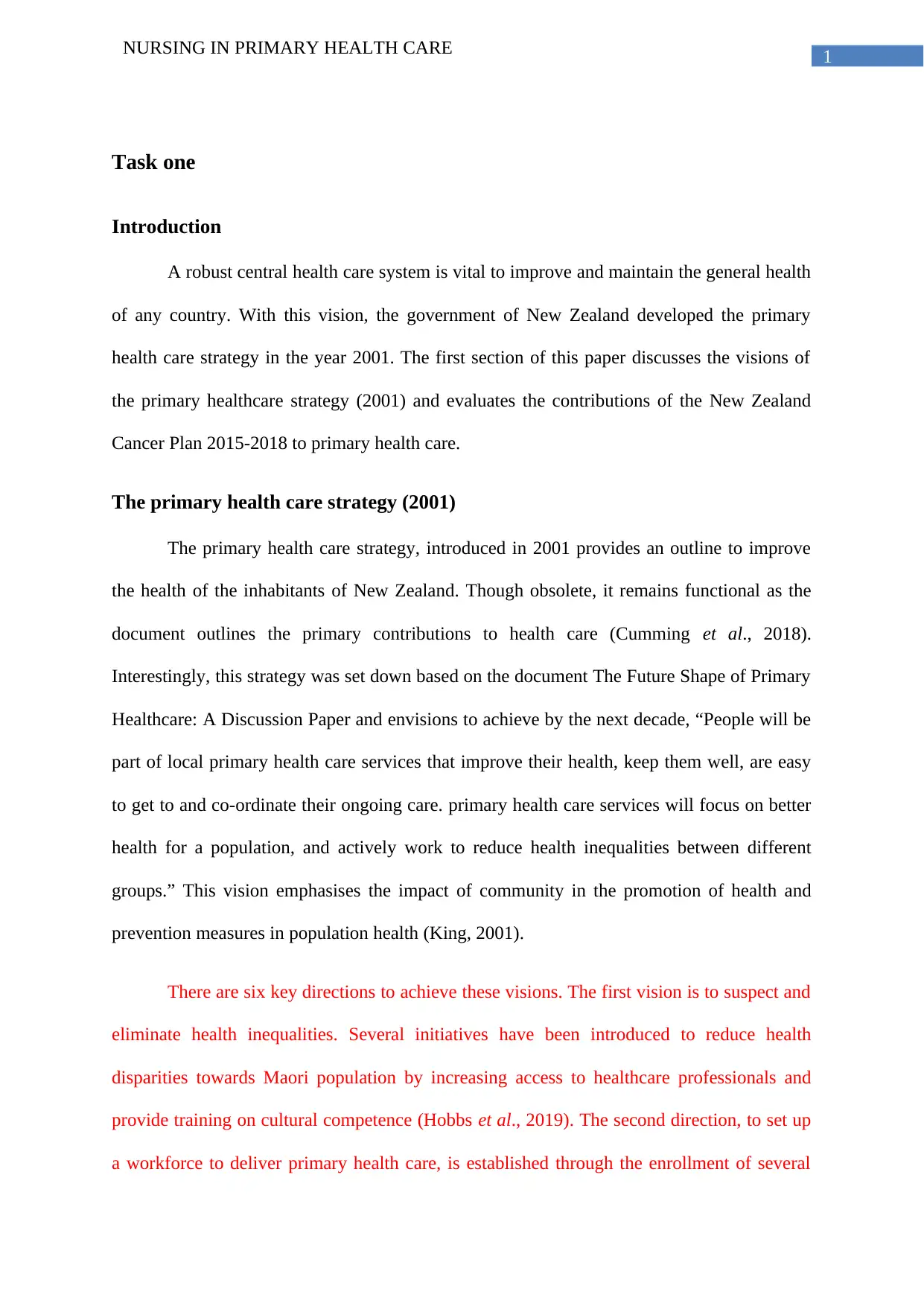
1NURSING IN PRIMARY HEALTH CARE
Task one
Introduction
A robust central health care system is vital to improve and maintain the general health
of any country. With this vision, the government of New Zealand developed the primary
health care strategy in the year 2001. The first section of this paper discusses the visions of
the primary healthcare strategy (2001) and evaluates the contributions of the New Zealand
Cancer Plan 2015-2018 to primary health care.
The primary health care strategy (2001)
The primary health care strategy, introduced in 2001 provides an outline to improve
the health of the inhabitants of New Zealand. Though obsolete, it remains functional as the
document outlines the primary contributions to health care (Cumming et al., 2018).
Interestingly, this strategy was set down based on the document The Future Shape of Primary
Healthcare: A Discussion Paper and envisions to achieve by the next decade, “People will be
part of local primary health care services that improve their health, keep them well, are easy
to get to and co-ordinate their ongoing care. primary health care services will focus on better
health for a population, and actively work to reduce health inequalities between different
groups.” This vision emphasises the impact of community in the promotion of health and
prevention measures in population health (King, 2001).
There are six key directions to achieve these visions. The first vision is to suspect and
eliminate health inequalities. Several initiatives have been introduced to reduce health
disparities towards Maori population by increasing access to healthcare professionals and
provide training on cultural competence (Hobbs et al., 2019). The second direction, to set up
a workforce to deliver primary health care, is established through the enrollment of several
Task one
Introduction
A robust central health care system is vital to improve and maintain the general health
of any country. With this vision, the government of New Zealand developed the primary
health care strategy in the year 2001. The first section of this paper discusses the visions of
the primary healthcare strategy (2001) and evaluates the contributions of the New Zealand
Cancer Plan 2015-2018 to primary health care.
The primary health care strategy (2001)
The primary health care strategy, introduced in 2001 provides an outline to improve
the health of the inhabitants of New Zealand. Though obsolete, it remains functional as the
document outlines the primary contributions to health care (Cumming et al., 2018).
Interestingly, this strategy was set down based on the document The Future Shape of Primary
Healthcare: A Discussion Paper and envisions to achieve by the next decade, “People will be
part of local primary health care services that improve their health, keep them well, are easy
to get to and co-ordinate their ongoing care. primary health care services will focus on better
health for a population, and actively work to reduce health inequalities between different
groups.” This vision emphasises the impact of community in the promotion of health and
prevention measures in population health (King, 2001).
There are six key directions to achieve these visions. The first vision is to suspect and
eliminate health inequalities. Several initiatives have been introduced to reduce health
disparities towards Maori population by increasing access to healthcare professionals and
provide training on cultural competence (Hobbs et al., 2019). The second direction, to set up
a workforce to deliver primary health care, is established through the enrollment of several
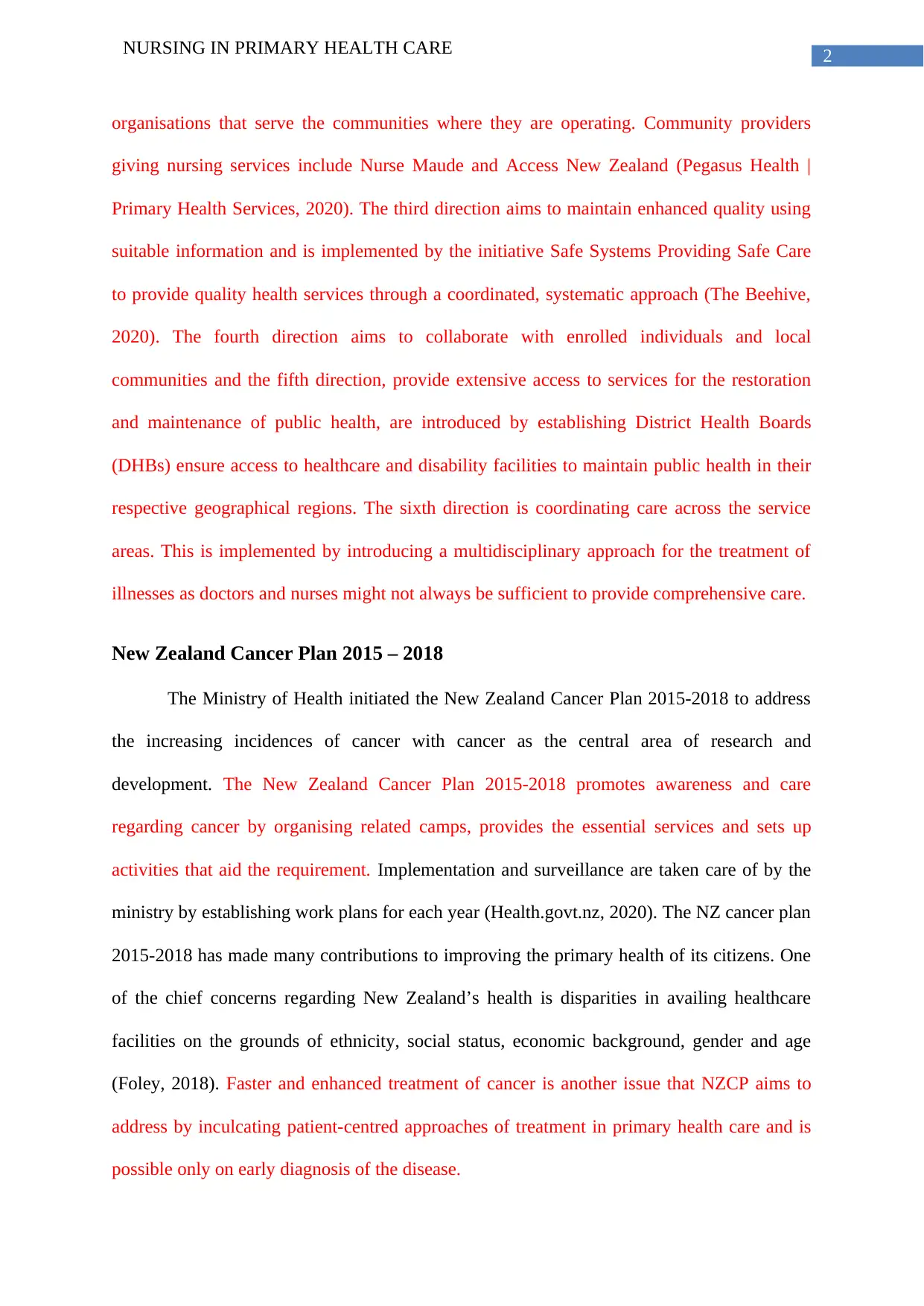
2NURSING IN PRIMARY HEALTH CARE
organisations that serve the communities where they are operating. Community providers
giving nursing services include Nurse Maude and Access New Zealand (Pegasus Health |
Primary Health Services, 2020). The third direction aims to maintain enhanced quality using
suitable information and is implemented by the initiative Safe Systems Providing Safe Care
to provide quality health services through a coordinated, systematic approach (The Beehive,
2020). The fourth direction aims to collaborate with enrolled individuals and local
communities and the fifth direction, provide extensive access to services for the restoration
and maintenance of public health, are introduced by establishing District Health Boards
(DHBs) ensure access to healthcare and disability facilities to maintain public health in their
respective geographical regions. The sixth direction is coordinating care across the service
areas. This is implemented by introducing a multidisciplinary approach for the treatment of
illnesses as doctors and nurses might not always be sufficient to provide comprehensive care.
New Zealand Cancer Plan 2015 – 2018
The Ministry of Health initiated the New Zealand Cancer Plan 2015-2018 to address
the increasing incidences of cancer with cancer as the central area of research and
development. The New Zealand Cancer Plan 2015-2018 promotes awareness and care
regarding cancer by organising related camps, provides the essential services and sets up
activities that aid the requirement. Implementation and surveillance are taken care of by the
ministry by establishing work plans for each year (Health.govt.nz, 2020). The NZ cancer plan
2015-2018 has made many contributions to improving the primary health of its citizens. One
of the chief concerns regarding New Zealand’s health is disparities in availing healthcare
facilities on the grounds of ethnicity, social status, economic background, gender and age
(Foley, 2018). Faster and enhanced treatment of cancer is another issue that NZCP aims to
address by inculcating patient-centred approaches of treatment in primary health care and is
possible only on early diagnosis of the disease.
organisations that serve the communities where they are operating. Community providers
giving nursing services include Nurse Maude and Access New Zealand (Pegasus Health |
Primary Health Services, 2020). The third direction aims to maintain enhanced quality using
suitable information and is implemented by the initiative Safe Systems Providing Safe Care
to provide quality health services through a coordinated, systematic approach (The Beehive,
2020). The fourth direction aims to collaborate with enrolled individuals and local
communities and the fifth direction, provide extensive access to services for the restoration
and maintenance of public health, are introduced by establishing District Health Boards
(DHBs) ensure access to healthcare and disability facilities to maintain public health in their
respective geographical regions. The sixth direction is coordinating care across the service
areas. This is implemented by introducing a multidisciplinary approach for the treatment of
illnesses as doctors and nurses might not always be sufficient to provide comprehensive care.
New Zealand Cancer Plan 2015 – 2018
The Ministry of Health initiated the New Zealand Cancer Plan 2015-2018 to address
the increasing incidences of cancer with cancer as the central area of research and
development. The New Zealand Cancer Plan 2015-2018 promotes awareness and care
regarding cancer by organising related camps, provides the essential services and sets up
activities that aid the requirement. Implementation and surveillance are taken care of by the
ministry by establishing work plans for each year (Health.govt.nz, 2020). The NZ cancer plan
2015-2018 has made many contributions to improving the primary health of its citizens. One
of the chief concerns regarding New Zealand’s health is disparities in availing healthcare
facilities on the grounds of ethnicity, social status, economic background, gender and age
(Foley, 2018). Faster and enhanced treatment of cancer is another issue that NZCP aims to
address by inculcating patient-centred approaches of treatment in primary health care and is
possible only on early diagnosis of the disease.
⊘ This is a preview!⊘
Do you want full access?
Subscribe today to unlock all pages.

Trusted by 1+ million students worldwide
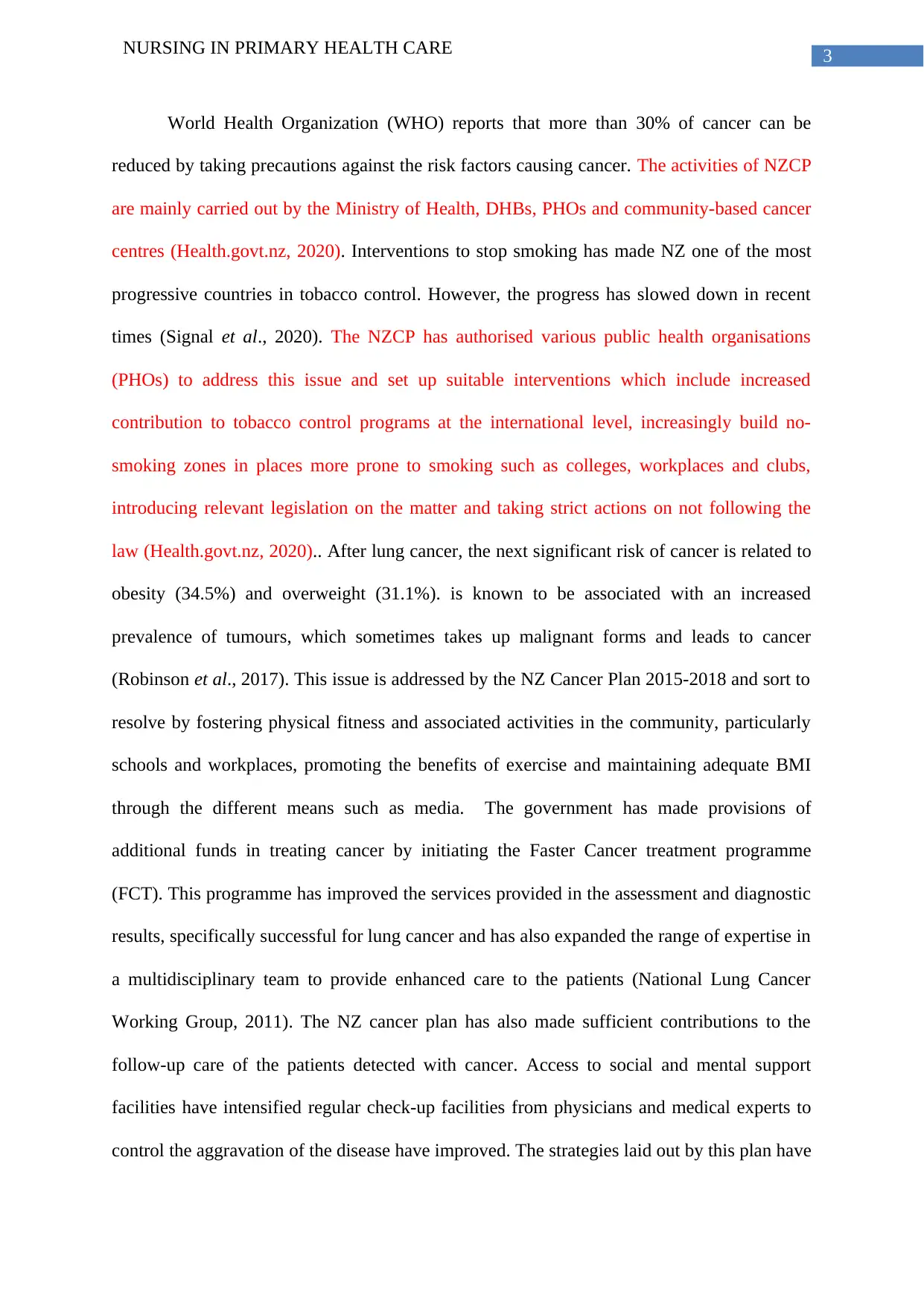
3NURSING IN PRIMARY HEALTH CARE
World Health Organization (WHO) reports that more than 30% of cancer can be
reduced by taking precautions against the risk factors causing cancer. The activities of NZCP
are mainly carried out by the Ministry of Health, DHBs, PHOs and community-based cancer
centres (Health.govt.nz, 2020). Interventions to stop smoking has made NZ one of the most
progressive countries in tobacco control. However, the progress has slowed down in recent
times (Signal et al., 2020). The NZCP has authorised various public health organisations
(PHOs) to address this issue and set up suitable interventions which include increased
contribution to tobacco control programs at the international level, increasingly build no-
smoking zones in places more prone to smoking such as colleges, workplaces and clubs,
introducing relevant legislation on the matter and taking strict actions on not following the
law (Health.govt.nz, 2020).. After lung cancer, the next significant risk of cancer is related to
obesity (34.5%) and overweight (31.1%). is known to be associated with an increased
prevalence of tumours, which sometimes takes up malignant forms and leads to cancer
(Robinson et al., 2017). This issue is addressed by the NZ Cancer Plan 2015-2018 and sort to
resolve by fostering physical fitness and associated activities in the community, particularly
schools and workplaces, promoting the benefits of exercise and maintaining adequate BMI
through the different means such as media. The government has made provisions of
additional funds in treating cancer by initiating the Faster Cancer treatment programme
(FCT). This programme has improved the services provided in the assessment and diagnostic
results, specifically successful for lung cancer and has also expanded the range of expertise in
a multidisciplinary team to provide enhanced care to the patients (National Lung Cancer
Working Group, 2011). The NZ cancer plan has also made sufficient contributions to the
follow-up care of the patients detected with cancer. Access to social and mental support
facilities have intensified regular check-up facilities from physicians and medical experts to
control the aggravation of the disease have improved. The strategies laid out by this plan have
World Health Organization (WHO) reports that more than 30% of cancer can be
reduced by taking precautions against the risk factors causing cancer. The activities of NZCP
are mainly carried out by the Ministry of Health, DHBs, PHOs and community-based cancer
centres (Health.govt.nz, 2020). Interventions to stop smoking has made NZ one of the most
progressive countries in tobacco control. However, the progress has slowed down in recent
times (Signal et al., 2020). The NZCP has authorised various public health organisations
(PHOs) to address this issue and set up suitable interventions which include increased
contribution to tobacco control programs at the international level, increasingly build no-
smoking zones in places more prone to smoking such as colleges, workplaces and clubs,
introducing relevant legislation on the matter and taking strict actions on not following the
law (Health.govt.nz, 2020).. After lung cancer, the next significant risk of cancer is related to
obesity (34.5%) and overweight (31.1%). is known to be associated with an increased
prevalence of tumours, which sometimes takes up malignant forms and leads to cancer
(Robinson et al., 2017). This issue is addressed by the NZ Cancer Plan 2015-2018 and sort to
resolve by fostering physical fitness and associated activities in the community, particularly
schools and workplaces, promoting the benefits of exercise and maintaining adequate BMI
through the different means such as media. The government has made provisions of
additional funds in treating cancer by initiating the Faster Cancer treatment programme
(FCT). This programme has improved the services provided in the assessment and diagnostic
results, specifically successful for lung cancer and has also expanded the range of expertise in
a multidisciplinary team to provide enhanced care to the patients (National Lung Cancer
Working Group, 2011). The NZ cancer plan has also made sufficient contributions to the
follow-up care of the patients detected with cancer. Access to social and mental support
facilities have intensified regular check-up facilities from physicians and medical experts to
control the aggravation of the disease have improved. The strategies laid out by this plan have
Paraphrase This Document
Need a fresh take? Get an instant paraphrase of this document with our AI Paraphraser
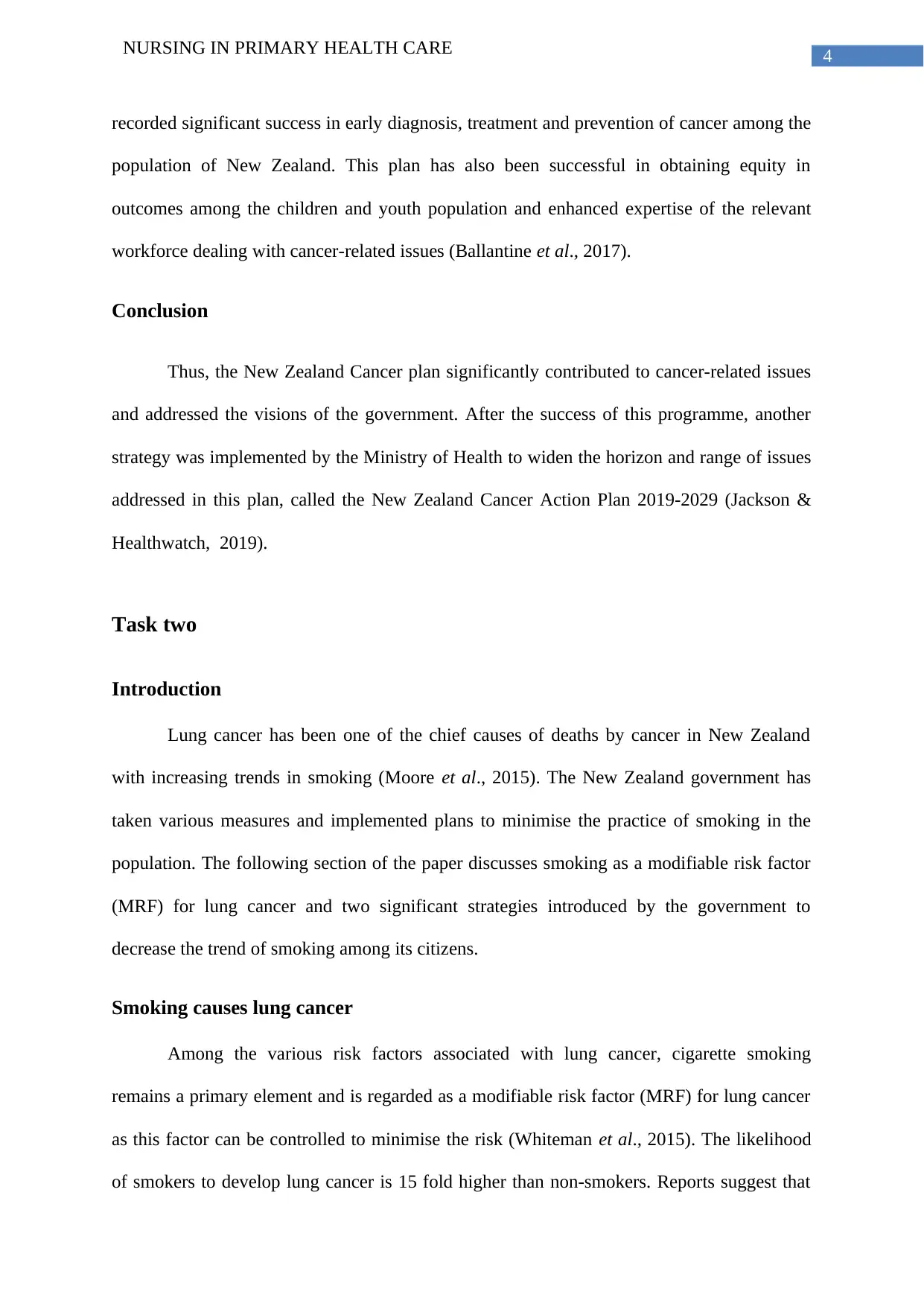
4NURSING IN PRIMARY HEALTH CARE
recorded significant success in early diagnosis, treatment and prevention of cancer among the
population of New Zealand. This plan has also been successful in obtaining equity in
outcomes among the children and youth population and enhanced expertise of the relevant
workforce dealing with cancer-related issues (Ballantine et al., 2017).
Conclusion
Thus, the New Zealand Cancer plan significantly contributed to cancer-related issues
and addressed the visions of the government. After the success of this programme, another
strategy was implemented by the Ministry of Health to widen the horizon and range of issues
addressed in this plan, called the New Zealand Cancer Action Plan 2019-2029 (Jackson &
Healthwatch, 2019).
Task two
Introduction
Lung cancer has been one of the chief causes of deaths by cancer in New Zealand
with increasing trends in smoking (Moore et al., 2015). The New Zealand government has
taken various measures and implemented plans to minimise the practice of smoking in the
population. The following section of the paper discusses smoking as a modifiable risk factor
(MRF) for lung cancer and two significant strategies introduced by the government to
decrease the trend of smoking among its citizens.
Smoking causes lung cancer
Among the various risk factors associated with lung cancer, cigarette smoking
remains a primary element and is regarded as a modifiable risk factor (MRF) for lung cancer
as this factor can be controlled to minimise the risk (Whiteman et al., 2015). The likelihood
of smokers to develop lung cancer is 15 fold higher than non-smokers. Reports suggest that
recorded significant success in early diagnosis, treatment and prevention of cancer among the
population of New Zealand. This plan has also been successful in obtaining equity in
outcomes among the children and youth population and enhanced expertise of the relevant
workforce dealing with cancer-related issues (Ballantine et al., 2017).
Conclusion
Thus, the New Zealand Cancer plan significantly contributed to cancer-related issues
and addressed the visions of the government. After the success of this programme, another
strategy was implemented by the Ministry of Health to widen the horizon and range of issues
addressed in this plan, called the New Zealand Cancer Action Plan 2019-2029 (Jackson &
Healthwatch, 2019).
Task two
Introduction
Lung cancer has been one of the chief causes of deaths by cancer in New Zealand
with increasing trends in smoking (Moore et al., 2015). The New Zealand government has
taken various measures and implemented plans to minimise the practice of smoking in the
population. The following section of the paper discusses smoking as a modifiable risk factor
(MRF) for lung cancer and two significant strategies introduced by the government to
decrease the trend of smoking among its citizens.
Smoking causes lung cancer
Among the various risk factors associated with lung cancer, cigarette smoking
remains a primary element and is regarded as a modifiable risk factor (MRF) for lung cancer
as this factor can be controlled to minimise the risk (Whiteman et al., 2015). The likelihood
of smokers to develop lung cancer is 15 fold higher than non-smokers. Reports suggest that
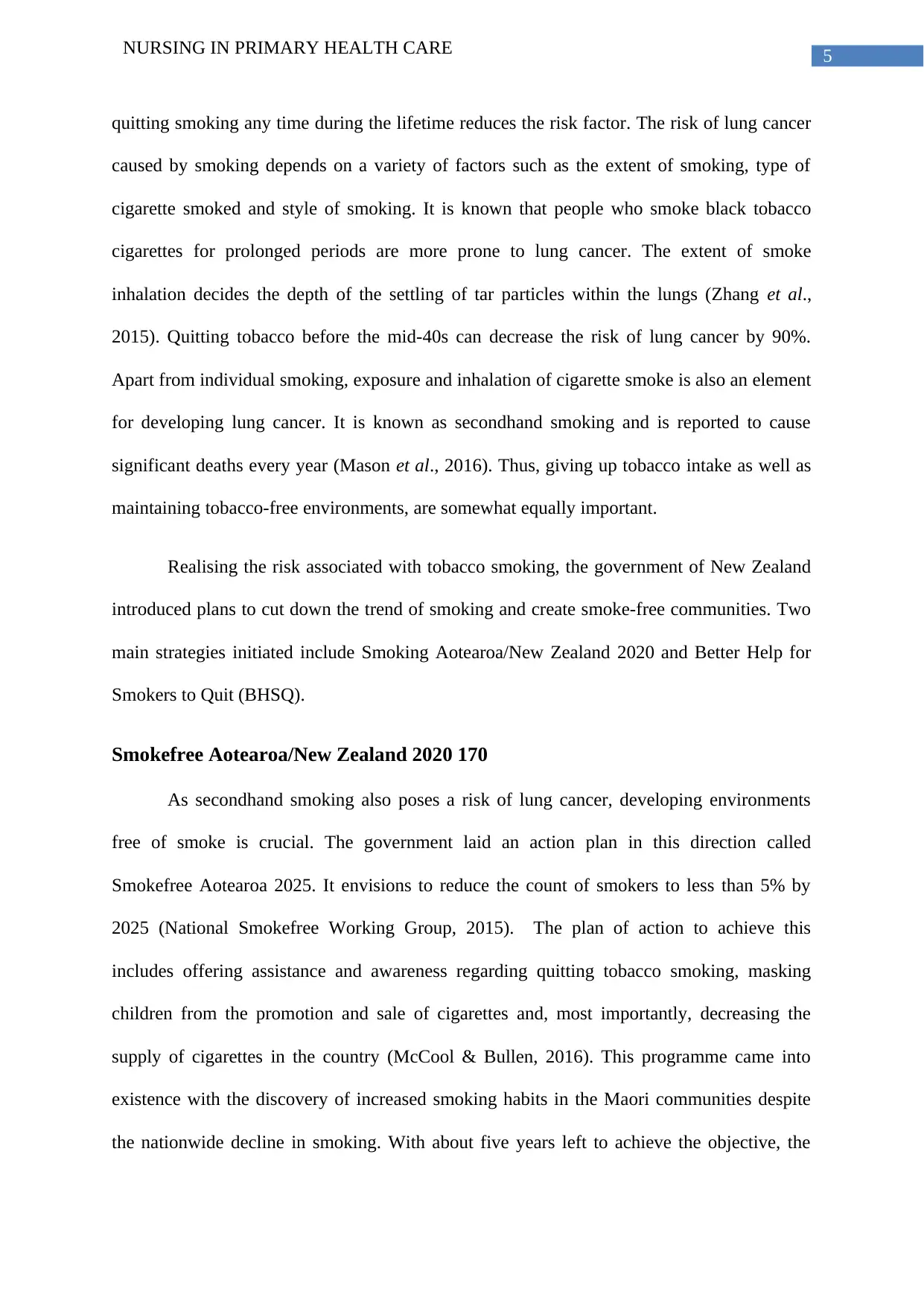
5NURSING IN PRIMARY HEALTH CARE
quitting smoking any time during the lifetime reduces the risk factor. The risk of lung cancer
caused by smoking depends on a variety of factors such as the extent of smoking, type of
cigarette smoked and style of smoking. It is known that people who smoke black tobacco
cigarettes for prolonged periods are more prone to lung cancer. The extent of smoke
inhalation decides the depth of the settling of tar particles within the lungs (Zhang et al.,
2015). Quitting tobacco before the mid-40s can decrease the risk of lung cancer by 90%.
Apart from individual smoking, exposure and inhalation of cigarette smoke is also an element
for developing lung cancer. It is known as secondhand smoking and is reported to cause
significant deaths every year (Mason et al., 2016). Thus, giving up tobacco intake as well as
maintaining tobacco-free environments, are somewhat equally important.
Realising the risk associated with tobacco smoking, the government of New Zealand
introduced plans to cut down the trend of smoking and create smoke-free communities. Two
main strategies initiated include Smoking Aotearoa/New Zealand 2020 and Better Help for
Smokers to Quit (BHSQ).
Smokefree Aotearoa/New Zealand 2020 170
As secondhand smoking also poses a risk of lung cancer, developing environments
free of smoke is crucial. The government laid an action plan in this direction called
Smokefree Aotearoa 2025. It envisions to reduce the count of smokers to less than 5% by
2025 (National Smokefree Working Group, 2015). The plan of action to achieve this
includes offering assistance and awareness regarding quitting tobacco smoking, masking
children from the promotion and sale of cigarettes and, most importantly, decreasing the
supply of cigarettes in the country (McCool & Bullen, 2016). This programme came into
existence with the discovery of increased smoking habits in the Maori communities despite
the nationwide decline in smoking. With about five years left to achieve the objective, the
quitting smoking any time during the lifetime reduces the risk factor. The risk of lung cancer
caused by smoking depends on a variety of factors such as the extent of smoking, type of
cigarette smoked and style of smoking. It is known that people who smoke black tobacco
cigarettes for prolonged periods are more prone to lung cancer. The extent of smoke
inhalation decides the depth of the settling of tar particles within the lungs (Zhang et al.,
2015). Quitting tobacco before the mid-40s can decrease the risk of lung cancer by 90%.
Apart from individual smoking, exposure and inhalation of cigarette smoke is also an element
for developing lung cancer. It is known as secondhand smoking and is reported to cause
significant deaths every year (Mason et al., 2016). Thus, giving up tobacco intake as well as
maintaining tobacco-free environments, are somewhat equally important.
Realising the risk associated with tobacco smoking, the government of New Zealand
introduced plans to cut down the trend of smoking and create smoke-free communities. Two
main strategies initiated include Smoking Aotearoa/New Zealand 2020 and Better Help for
Smokers to Quit (BHSQ).
Smokefree Aotearoa/New Zealand 2020 170
As secondhand smoking also poses a risk of lung cancer, developing environments
free of smoke is crucial. The government laid an action plan in this direction called
Smokefree Aotearoa 2025. It envisions to reduce the count of smokers to less than 5% by
2025 (National Smokefree Working Group, 2015). The plan of action to achieve this
includes offering assistance and awareness regarding quitting tobacco smoking, masking
children from the promotion and sale of cigarettes and, most importantly, decreasing the
supply of cigarettes in the country (McCool & Bullen, 2016). This programme came into
existence with the discovery of increased smoking habits in the Maori communities despite
the nationwide decline in smoking. With about five years left to achieve the objective, the
⊘ This is a preview!⊘
Do you want full access?
Subscribe today to unlock all pages.

Trusted by 1+ million students worldwide
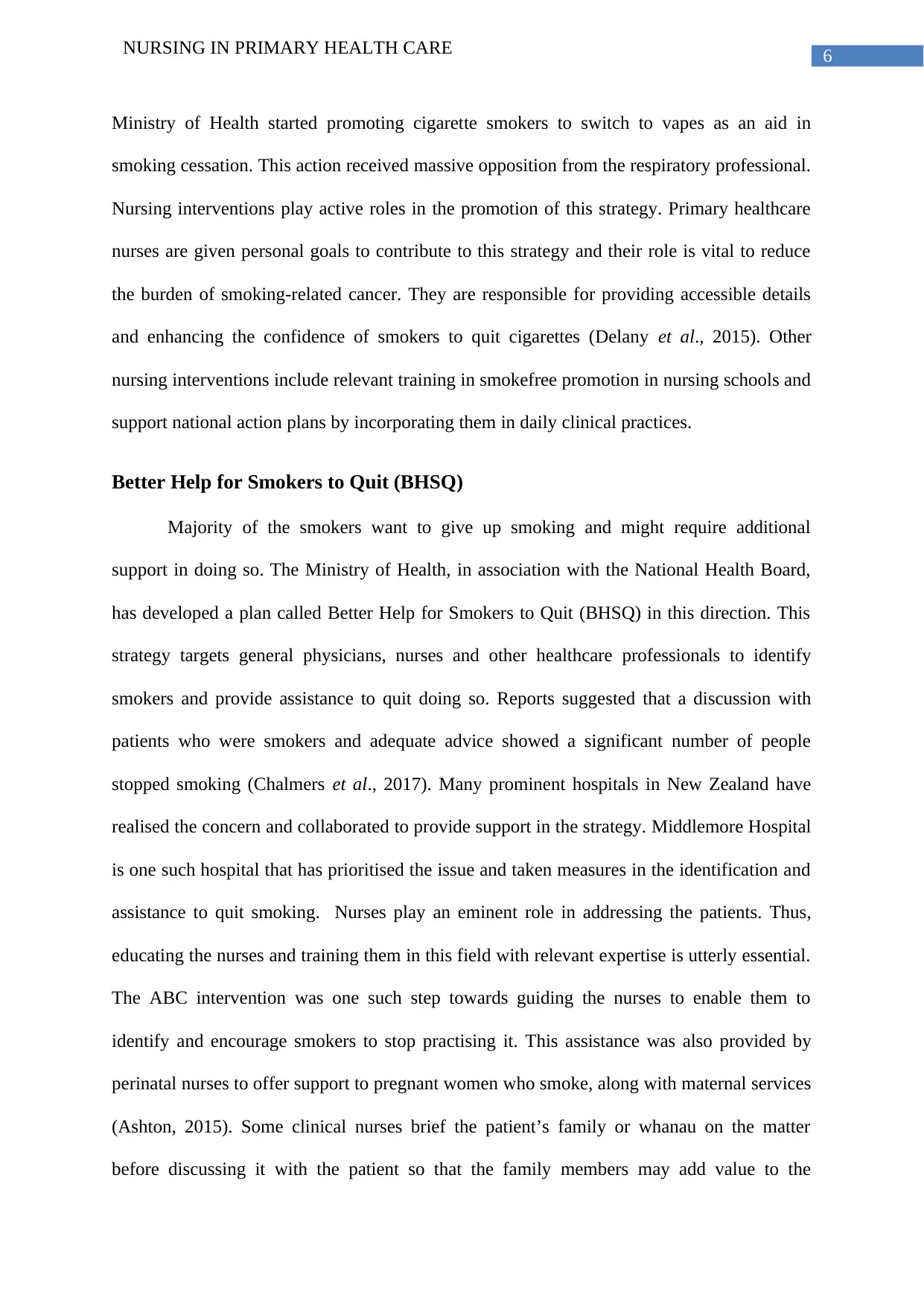
6NURSING IN PRIMARY HEALTH CARE
Ministry of Health started promoting cigarette smokers to switch to vapes as an aid in
smoking cessation. This action received massive opposition from the respiratory professional.
Nursing interventions play active roles in the promotion of this strategy. Primary healthcare
nurses are given personal goals to contribute to this strategy and their role is vital to reduce
the burden of smoking-related cancer. They are responsible for providing accessible details
and enhancing the confidence of smokers to quit cigarettes (Delany et al., 2015). Other
nursing interventions include relevant training in smokefree promotion in nursing schools and
support national action plans by incorporating them in daily clinical practices.
Better Help for Smokers to Quit (BHSQ)
Majority of the smokers want to give up smoking and might require additional
support in doing so. The Ministry of Health, in association with the National Health Board,
has developed a plan called Better Help for Smokers to Quit (BHSQ) in this direction. This
strategy targets general physicians, nurses and other healthcare professionals to identify
smokers and provide assistance to quit doing so. Reports suggested that a discussion with
patients who were smokers and adequate advice showed a significant number of people
stopped smoking (Chalmers et al., 2017). Many prominent hospitals in New Zealand have
realised the concern and collaborated to provide support in the strategy. Middlemore Hospital
is one such hospital that has prioritised the issue and taken measures in the identification and
assistance to quit smoking. Nurses play an eminent role in addressing the patients. Thus,
educating the nurses and training them in this field with relevant expertise is utterly essential.
The ABC intervention was one such step towards guiding the nurses to enable them to
identify and encourage smokers to stop practising it. This assistance was also provided by
perinatal nurses to offer support to pregnant women who smoke, along with maternal services
(Ashton, 2015). Some clinical nurses brief the patient’s family or whanau on the matter
before discussing it with the patient so that the family members may add value to the
Ministry of Health started promoting cigarette smokers to switch to vapes as an aid in
smoking cessation. This action received massive opposition from the respiratory professional.
Nursing interventions play active roles in the promotion of this strategy. Primary healthcare
nurses are given personal goals to contribute to this strategy and their role is vital to reduce
the burden of smoking-related cancer. They are responsible for providing accessible details
and enhancing the confidence of smokers to quit cigarettes (Delany et al., 2015). Other
nursing interventions include relevant training in smokefree promotion in nursing schools and
support national action plans by incorporating them in daily clinical practices.
Better Help for Smokers to Quit (BHSQ)
Majority of the smokers want to give up smoking and might require additional
support in doing so. The Ministry of Health, in association with the National Health Board,
has developed a plan called Better Help for Smokers to Quit (BHSQ) in this direction. This
strategy targets general physicians, nurses and other healthcare professionals to identify
smokers and provide assistance to quit doing so. Reports suggested that a discussion with
patients who were smokers and adequate advice showed a significant number of people
stopped smoking (Chalmers et al., 2017). Many prominent hospitals in New Zealand have
realised the concern and collaborated to provide support in the strategy. Middlemore Hospital
is one such hospital that has prioritised the issue and taken measures in the identification and
assistance to quit smoking. Nurses play an eminent role in addressing the patients. Thus,
educating the nurses and training them in this field with relevant expertise is utterly essential.
The ABC intervention was one such step towards guiding the nurses to enable them to
identify and encourage smokers to stop practising it. This assistance was also provided by
perinatal nurses to offer support to pregnant women who smoke, along with maternal services
(Ashton, 2015). Some clinical nurses brief the patient’s family or whanau on the matter
before discussing it with the patient so that the family members may add value to the
Paraphrase This Document
Need a fresh take? Get an instant paraphrase of this document with our AI Paraphraser
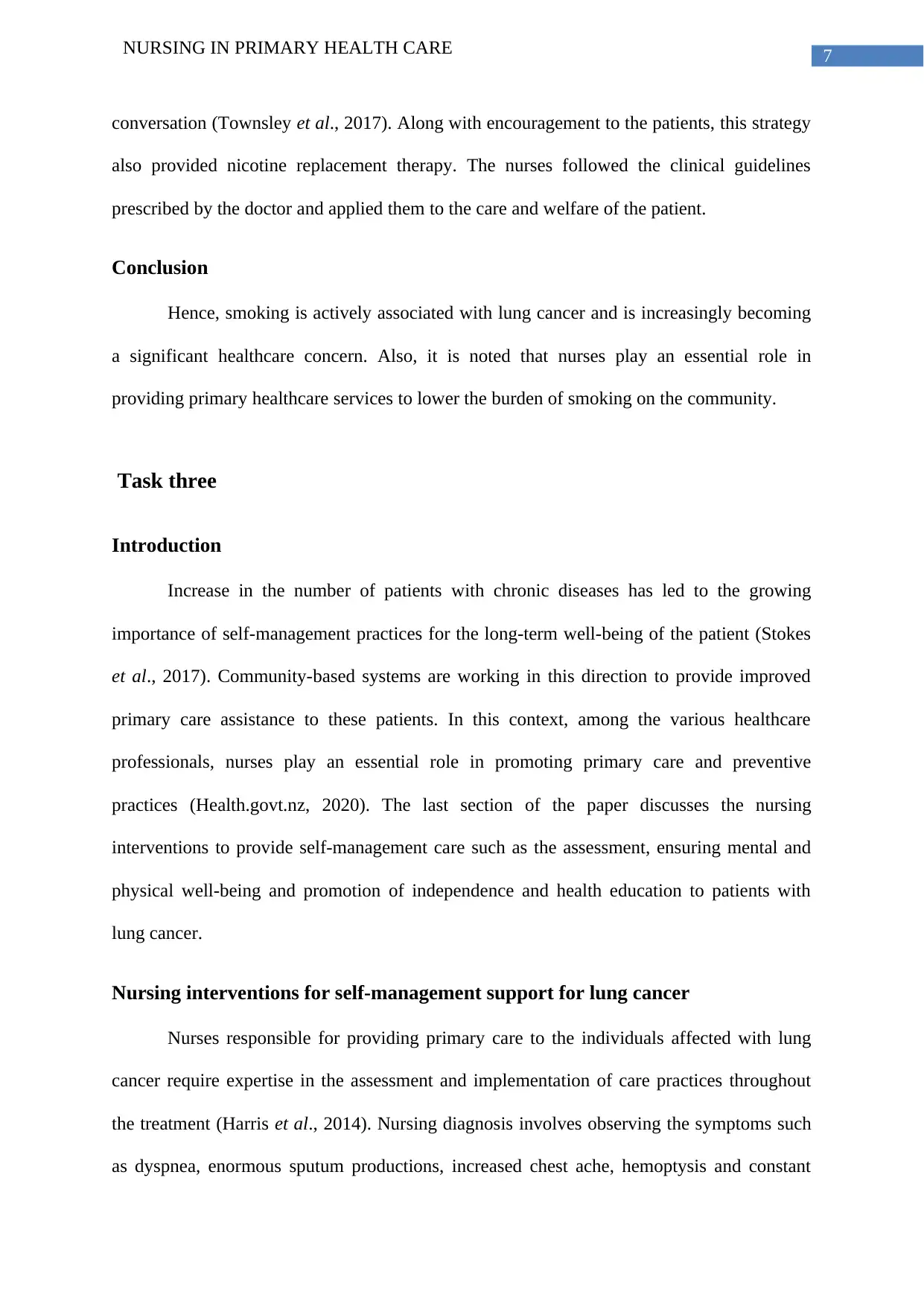
7NURSING IN PRIMARY HEALTH CARE
conversation (Townsley et al., 2017). Along with encouragement to the patients, this strategy
also provided nicotine replacement therapy. The nurses followed the clinical guidelines
prescribed by the doctor and applied them to the care and welfare of the patient.
Conclusion
Hence, smoking is actively associated with lung cancer and is increasingly becoming
a significant healthcare concern. Also, it is noted that nurses play an essential role in
providing primary healthcare services to lower the burden of smoking on the community.
Task three
Introduction
Increase in the number of patients with chronic diseases has led to the growing
importance of self-management practices for the long-term well-being of the patient (Stokes
et al., 2017). Community-based systems are working in this direction to provide improved
primary care assistance to these patients. In this context, among the various healthcare
professionals, nurses play an essential role in promoting primary care and preventive
practices (Health.govt.nz, 2020). The last section of the paper discusses the nursing
interventions to provide self-management care such as the assessment, ensuring mental and
physical well-being and promotion of independence and health education to patients with
lung cancer.
Nursing interventions for self-management support for lung cancer
Nurses responsible for providing primary care to the individuals affected with lung
cancer require expertise in the assessment and implementation of care practices throughout
the treatment (Harris et al., 2014). Nursing diagnosis involves observing the symptoms such
as dyspnea, enormous sputum productions, increased chest ache, hemoptysis and constant
conversation (Townsley et al., 2017). Along with encouragement to the patients, this strategy
also provided nicotine replacement therapy. The nurses followed the clinical guidelines
prescribed by the doctor and applied them to the care and welfare of the patient.
Conclusion
Hence, smoking is actively associated with lung cancer and is increasingly becoming
a significant healthcare concern. Also, it is noted that nurses play an essential role in
providing primary healthcare services to lower the burden of smoking on the community.
Task three
Introduction
Increase in the number of patients with chronic diseases has led to the growing
importance of self-management practices for the long-term well-being of the patient (Stokes
et al., 2017). Community-based systems are working in this direction to provide improved
primary care assistance to these patients. In this context, among the various healthcare
professionals, nurses play an essential role in promoting primary care and preventive
practices (Health.govt.nz, 2020). The last section of the paper discusses the nursing
interventions to provide self-management care such as the assessment, ensuring mental and
physical well-being and promotion of independence and health education to patients with
lung cancer.
Nursing interventions for self-management support for lung cancer
Nurses responsible for providing primary care to the individuals affected with lung
cancer require expertise in the assessment and implementation of care practices throughout
the treatment (Harris et al., 2014). Nursing diagnosis involves observing the symptoms such
as dyspnea, enormous sputum productions, increased chest ache, hemoptysis and constant
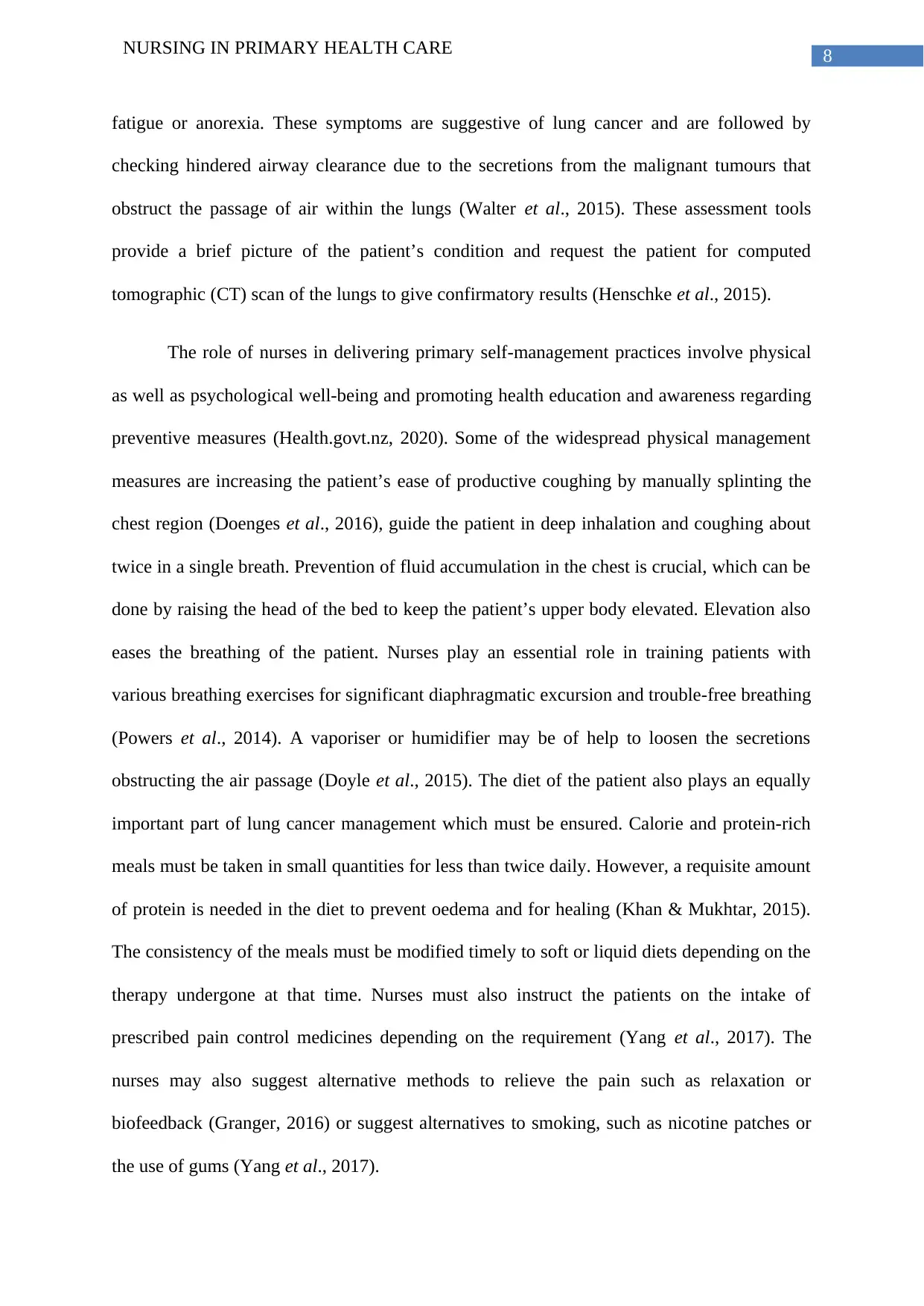
8NURSING IN PRIMARY HEALTH CARE
fatigue or anorexia. These symptoms are suggestive of lung cancer and are followed by
checking hindered airway clearance due to the secretions from the malignant tumours that
obstruct the passage of air within the lungs (Walter et al., 2015). These assessment tools
provide a brief picture of the patient’s condition and request the patient for computed
tomographic (CT) scan of the lungs to give confirmatory results (Henschke et al., 2015).
The role of nurses in delivering primary self-management practices involve physical
as well as psychological well-being and promoting health education and awareness regarding
preventive measures (Health.govt.nz, 2020). Some of the widespread physical management
measures are increasing the patient’s ease of productive coughing by manually splinting the
chest region (Doenges et al., 2016), guide the patient in deep inhalation and coughing about
twice in a single breath. Prevention of fluid accumulation in the chest is crucial, which can be
done by raising the head of the bed to keep the patient’s upper body elevated. Elevation also
eases the breathing of the patient. Nurses play an essential role in training patients with
various breathing exercises for significant diaphragmatic excursion and trouble-free breathing
(Powers et al., 2014). A vaporiser or humidifier may be of help to loosen the secretions
obstructing the air passage (Doyle et al., 2015). The diet of the patient also plays an equally
important part of lung cancer management which must be ensured. Calorie and protein-rich
meals must be taken in small quantities for less than twice daily. However, a requisite amount
of protein is needed in the diet to prevent oedema and for healing (Khan & Mukhtar, 2015).
The consistency of the meals must be modified timely to soft or liquid diets depending on the
therapy undergone at that time. Nurses must also instruct the patients on the intake of
prescribed pain control medicines depending on the requirement (Yang et al., 2017). The
nurses may also suggest alternative methods to relieve the pain such as relaxation or
biofeedback (Granger, 2016) or suggest alternatives to smoking, such as nicotine patches or
the use of gums (Yang et al., 2017).
fatigue or anorexia. These symptoms are suggestive of lung cancer and are followed by
checking hindered airway clearance due to the secretions from the malignant tumours that
obstruct the passage of air within the lungs (Walter et al., 2015). These assessment tools
provide a brief picture of the patient’s condition and request the patient for computed
tomographic (CT) scan of the lungs to give confirmatory results (Henschke et al., 2015).
The role of nurses in delivering primary self-management practices involve physical
as well as psychological well-being and promoting health education and awareness regarding
preventive measures (Health.govt.nz, 2020). Some of the widespread physical management
measures are increasing the patient’s ease of productive coughing by manually splinting the
chest region (Doenges et al., 2016), guide the patient in deep inhalation and coughing about
twice in a single breath. Prevention of fluid accumulation in the chest is crucial, which can be
done by raising the head of the bed to keep the patient’s upper body elevated. Elevation also
eases the breathing of the patient. Nurses play an essential role in training patients with
various breathing exercises for significant diaphragmatic excursion and trouble-free breathing
(Powers et al., 2014). A vaporiser or humidifier may be of help to loosen the secretions
obstructing the air passage (Doyle et al., 2015). The diet of the patient also plays an equally
important part of lung cancer management which must be ensured. Calorie and protein-rich
meals must be taken in small quantities for less than twice daily. However, a requisite amount
of protein is needed in the diet to prevent oedema and for healing (Khan & Mukhtar, 2015).
The consistency of the meals must be modified timely to soft or liquid diets depending on the
therapy undergone at that time. Nurses must also instruct the patients on the intake of
prescribed pain control medicines depending on the requirement (Yang et al., 2017). The
nurses may also suggest alternative methods to relieve the pain such as relaxation or
biofeedback (Granger, 2016) or suggest alternatives to smoking, such as nicotine patches or
the use of gums (Yang et al., 2017).
⊘ This is a preview!⊘
Do you want full access?
Subscribe today to unlock all pages.

Trusted by 1+ million students worldwide
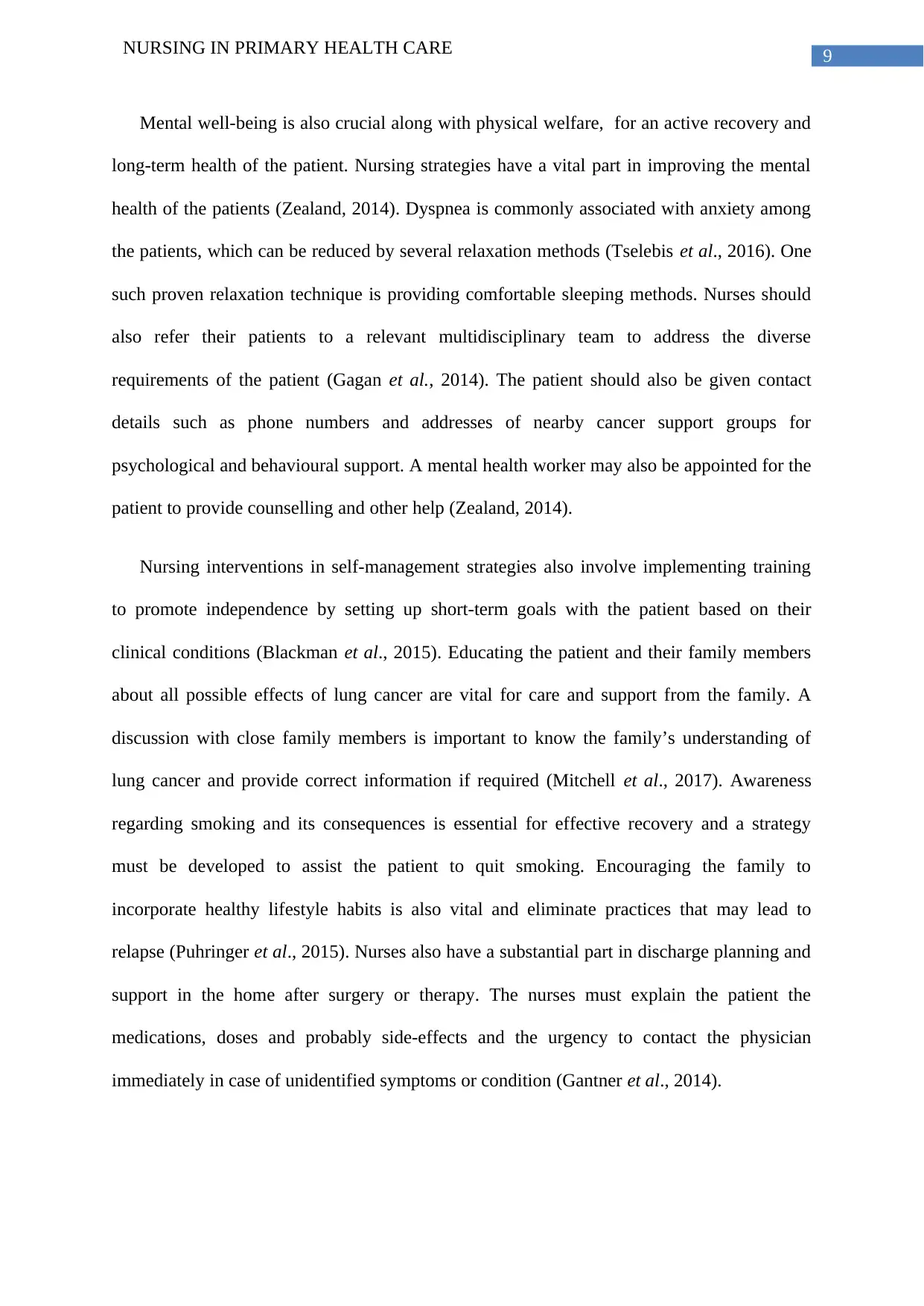
9NURSING IN PRIMARY HEALTH CARE
Mental well-being is also crucial along with physical welfare, for an active recovery and
long-term health of the patient. Nursing strategies have a vital part in improving the mental
health of the patients (Zealand, 2014). Dyspnea is commonly associated with anxiety among
the patients, which can be reduced by several relaxation methods (Tselebis et al., 2016). One
such proven relaxation technique is providing comfortable sleeping methods. Nurses should
also refer their patients to a relevant multidisciplinary team to address the diverse
requirements of the patient (Gagan et al., 2014). The patient should also be given contact
details such as phone numbers and addresses of nearby cancer support groups for
psychological and behavioural support. A mental health worker may also be appointed for the
patient to provide counselling and other help (Zealand, 2014).
Nursing interventions in self-management strategies also involve implementing training
to promote independence by setting up short-term goals with the patient based on their
clinical conditions (Blackman et al., 2015). Educating the patient and their family members
about all possible effects of lung cancer are vital for care and support from the family. A
discussion with close family members is important to know the family’s understanding of
lung cancer and provide correct information if required (Mitchell et al., 2017). Awareness
regarding smoking and its consequences is essential for effective recovery and a strategy
must be developed to assist the patient to quit smoking. Encouraging the family to
incorporate healthy lifestyle habits is also vital and eliminate practices that may lead to
relapse (Puhringer et al., 2015). Nurses also have a substantial part in discharge planning and
support in the home after surgery or therapy. The nurses must explain the patient the
medications, doses and probably side-effects and the urgency to contact the physician
immediately in case of unidentified symptoms or condition (Gantner et al., 2014).
Mental well-being is also crucial along with physical welfare, for an active recovery and
long-term health of the patient. Nursing strategies have a vital part in improving the mental
health of the patients (Zealand, 2014). Dyspnea is commonly associated with anxiety among
the patients, which can be reduced by several relaxation methods (Tselebis et al., 2016). One
such proven relaxation technique is providing comfortable sleeping methods. Nurses should
also refer their patients to a relevant multidisciplinary team to address the diverse
requirements of the patient (Gagan et al., 2014). The patient should also be given contact
details such as phone numbers and addresses of nearby cancer support groups for
psychological and behavioural support. A mental health worker may also be appointed for the
patient to provide counselling and other help (Zealand, 2014).
Nursing interventions in self-management strategies also involve implementing training
to promote independence by setting up short-term goals with the patient based on their
clinical conditions (Blackman et al., 2015). Educating the patient and their family members
about all possible effects of lung cancer are vital for care and support from the family. A
discussion with close family members is important to know the family’s understanding of
lung cancer and provide correct information if required (Mitchell et al., 2017). Awareness
regarding smoking and its consequences is essential for effective recovery and a strategy
must be developed to assist the patient to quit smoking. Encouraging the family to
incorporate healthy lifestyle habits is also vital and eliminate practices that may lead to
relapse (Puhringer et al., 2015). Nurses also have a substantial part in discharge planning and
support in the home after surgery or therapy. The nurses must explain the patient the
medications, doses and probably side-effects and the urgency to contact the physician
immediately in case of unidentified symptoms or condition (Gantner et al., 2014).
Paraphrase This Document
Need a fresh take? Get an instant paraphrase of this document with our AI Paraphraser
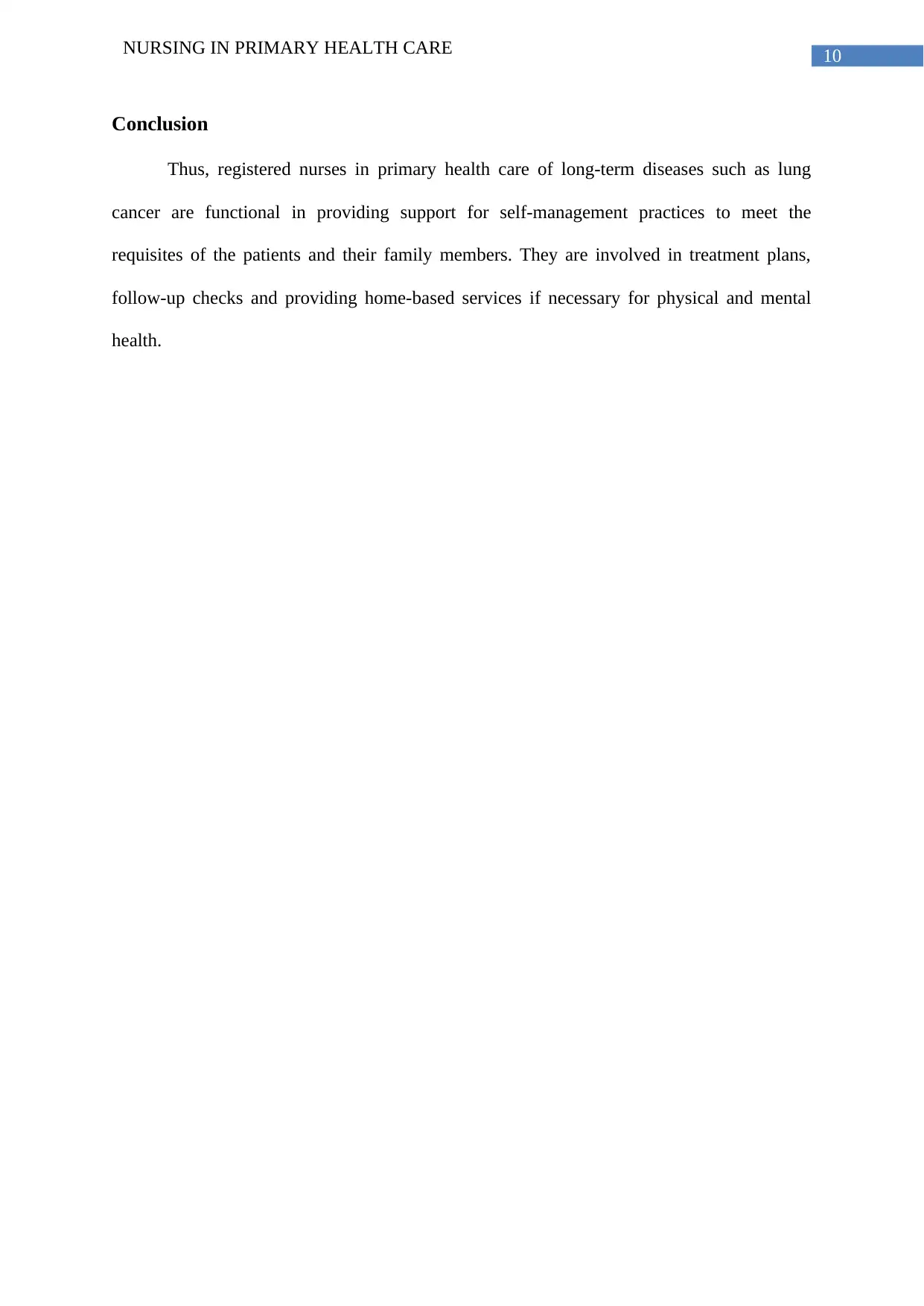
10NURSING IN PRIMARY HEALTH CARE
Conclusion
Thus, registered nurses in primary health care of long-term diseases such as lung
cancer are functional in providing support for self-management practices to meet the
requisites of the patients and their family members. They are involved in treatment plans,
follow-up checks and providing home-based services if necessary for physical and mental
health.
Conclusion
Thus, registered nurses in primary health care of long-term diseases such as lung
cancer are functional in providing support for self-management practices to meet the
requisites of the patients and their family members. They are involved in treatment plans,
follow-up checks and providing home-based services if necessary for physical and mental
health.
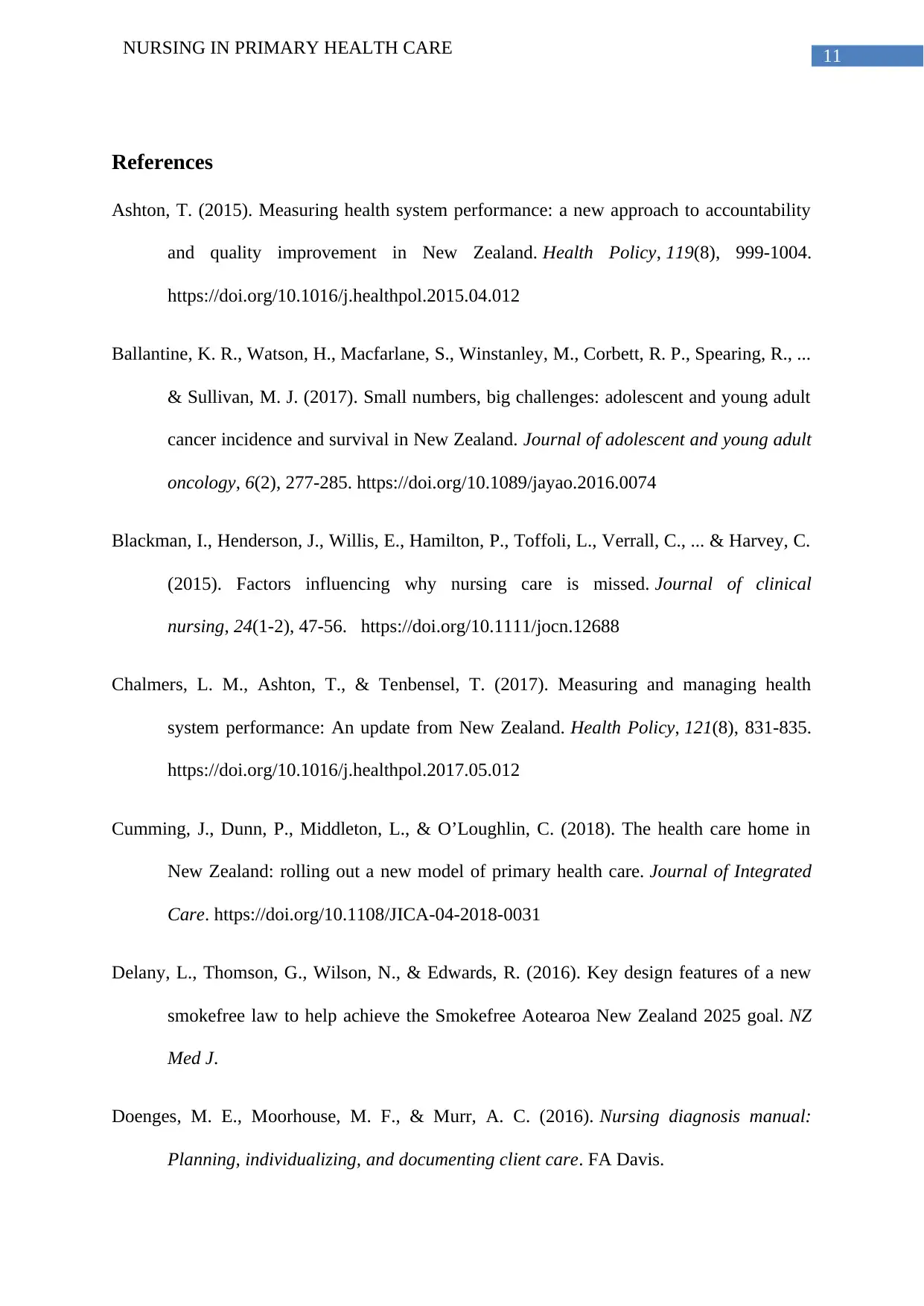
11NURSING IN PRIMARY HEALTH CARE
References
Ashton, T. (2015). Measuring health system performance: a new approach to accountability
and quality improvement in New Zealand. Health Policy, 119(8), 999-1004.
https://doi.org/10.1016/j.healthpol.2015.04.012
Ballantine, K. R., Watson, H., Macfarlane, S., Winstanley, M., Corbett, R. P., Spearing, R., ...
& Sullivan, M. J. (2017). Small numbers, big challenges: adolescent and young adult
cancer incidence and survival in New Zealand. Journal of adolescent and young adult
oncology, 6(2), 277-285. https://doi.org/10.1089/jayao.2016.0074
Blackman, I., Henderson, J., Willis, E., Hamilton, P., Toffoli, L., Verrall, C., ... & Harvey, C.
(2015). Factors influencing why nursing care is missed. Journal of clinical
nursing, 24(1-2), 47-56. https://doi.org/10.1111/jocn.12688
Chalmers, L. M., Ashton, T., & Tenbensel, T. (2017). Measuring and managing health
system performance: An update from New Zealand. Health Policy, 121(8), 831-835.
https://doi.org/10.1016/j.healthpol.2017.05.012
Cumming, J., Dunn, P., Middleton, L., & O’Loughlin, C. (2018). The health care home in
New Zealand: rolling out a new model of primary health care. Journal of Integrated
Care. https://doi.org/10.1108/JICA-04-2018-0031
Delany, L., Thomson, G., Wilson, N., & Edwards, R. (2016). Key design features of a new
smokefree law to help achieve the Smokefree Aotearoa New Zealand 2025 goal. NZ
Med J.
Doenges, M. E., Moorhouse, M. F., & Murr, A. C. (2016). Nursing diagnosis manual:
Planning, individualizing, and documenting client care. FA Davis.
References
Ashton, T. (2015). Measuring health system performance: a new approach to accountability
and quality improvement in New Zealand. Health Policy, 119(8), 999-1004.
https://doi.org/10.1016/j.healthpol.2015.04.012
Ballantine, K. R., Watson, H., Macfarlane, S., Winstanley, M., Corbett, R. P., Spearing, R., ...
& Sullivan, M. J. (2017). Small numbers, big challenges: adolescent and young adult
cancer incidence and survival in New Zealand. Journal of adolescent and young adult
oncology, 6(2), 277-285. https://doi.org/10.1089/jayao.2016.0074
Blackman, I., Henderson, J., Willis, E., Hamilton, P., Toffoli, L., Verrall, C., ... & Harvey, C.
(2015). Factors influencing why nursing care is missed. Journal of clinical
nursing, 24(1-2), 47-56. https://doi.org/10.1111/jocn.12688
Chalmers, L. M., Ashton, T., & Tenbensel, T. (2017). Measuring and managing health
system performance: An update from New Zealand. Health Policy, 121(8), 831-835.
https://doi.org/10.1016/j.healthpol.2017.05.012
Cumming, J., Dunn, P., Middleton, L., & O’Loughlin, C. (2018). The health care home in
New Zealand: rolling out a new model of primary health care. Journal of Integrated
Care. https://doi.org/10.1108/JICA-04-2018-0031
Delany, L., Thomson, G., Wilson, N., & Edwards, R. (2016). Key design features of a new
smokefree law to help achieve the Smokefree Aotearoa New Zealand 2025 goal. NZ
Med J.
Doenges, M. E., Moorhouse, M. F., & Murr, A. C. (2016). Nursing diagnosis manual:
Planning, individualizing, and documenting client care. FA Davis.
⊘ This is a preview!⊘
Do you want full access?
Subscribe today to unlock all pages.

Trusted by 1+ million students worldwide
1 out of 17
Related Documents
Your All-in-One AI-Powered Toolkit for Academic Success.
+13062052269
info@desklib.com
Available 24*7 on WhatsApp / Email
![[object Object]](/_next/static/media/star-bottom.7253800d.svg)
Unlock your academic potential
Copyright © 2020–2025 A2Z Services. All Rights Reserved. Developed and managed by ZUCOL.





